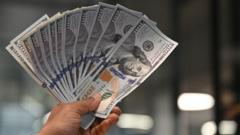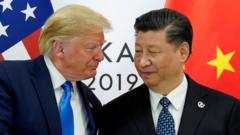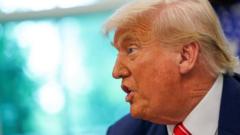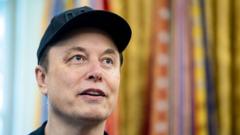**As leaders of Canada’s major parties faced off, the impact of off-stage figures and policy distinctions took center stage.**
**Debate Spotlight: Key Insights from the Canadian Leaders' Showdown**
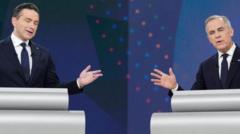
**Debate Spotlight: Key Insights from the Canadian Leaders' Showdown**
**Analysis of the final debate reveals political dynamics and influence ahead of the election.**
In the lead-up to Canada’s general election, the leaders of the four primary federal parties engaged in their second and final debate, with much anticipation surrounding how Liberal leader Mark Carney would perform under pressure. Carney, polling as a frontrunner, previously maintained composure in a French debate despite language limitations. However, during Thursday’s primetime discussion, Conservative leader Pierre Poilievre, New Democratic Party (NDP) leader Jagmeet Singh, and Bloc Québécois leader Yves-Francois Blanchet did not hold back in their critiques.
A notable shadow cast over the debate was that of former Prime Minister Justin Trudeau. Poilievre aimed to link Carney with the "lost Liberal decade," questioning how Carney could be perceived as a new face amidst the party's longstanding concerns over affordability and living costs. Blanchet challenged Carney directly, asserting the necessity for tangible evidence of change. Carney, however, pointed out his limited tenure in leadership, emphasizing his distinct identity from Trudeau.
Trade relations, particularly regarding tariffs imposed by US President Donald Trump, were a focal point. The leaders acknowledged the complexities of negotiating with the US, where trumpeted "dollar-for-dollar" tariffs have transitioned towards more targeted measures, a stance Carney admitted to aligning with. Following discussions with Trump in March, Carney reported a more respectful dynamic, indicating potential openings for constructive relations post-election.
Beyond Trump, substantive discussions emerged on domestic policy issues such as housing affordability, crime, and healthcare. Poilievre's lean toward minimizing government intervention for economic growth contrasted sharply with Singh's push for expanded social programs like national dental and pharmacare. Carney advocated for a balanced, centrist approach, positioning the government as a catalyst rather than a primary actor.
In Canada’s robust political landscape, where multiple parties vie for attention, the debate showcased the struggles of smaller parties like the NDP and Bloc. With polls revealing dwindling support, Singh fought to assert his party's relevance while Blanchet capitalized on opportunities to emphasize Quebec-focused issues. The NDP, trailing in the polls, faced significant challenges to maintaining influence, with current predictions suggesting a steep decline in representation.
Amidst exchanges, the Canadian leaders exhibited a prevailing sense of civility. Carney and Poilievre exemplified this decorum, exchanging amicable gestures even amid robust discussions, setting a contrasting tone to more contentious political dialogues witnessed in other countries.
As voters approach the polls, these debates highlight the varied approaches to significant national issues, underlining the clear distinctions available to Canadians in their choice of political leadership.
A notable shadow cast over the debate was that of former Prime Minister Justin Trudeau. Poilievre aimed to link Carney with the "lost Liberal decade," questioning how Carney could be perceived as a new face amidst the party's longstanding concerns over affordability and living costs. Blanchet challenged Carney directly, asserting the necessity for tangible evidence of change. Carney, however, pointed out his limited tenure in leadership, emphasizing his distinct identity from Trudeau.
Trade relations, particularly regarding tariffs imposed by US President Donald Trump, were a focal point. The leaders acknowledged the complexities of negotiating with the US, where trumpeted "dollar-for-dollar" tariffs have transitioned towards more targeted measures, a stance Carney admitted to aligning with. Following discussions with Trump in March, Carney reported a more respectful dynamic, indicating potential openings for constructive relations post-election.
Beyond Trump, substantive discussions emerged on domestic policy issues such as housing affordability, crime, and healthcare. Poilievre's lean toward minimizing government intervention for economic growth contrasted sharply with Singh's push for expanded social programs like national dental and pharmacare. Carney advocated for a balanced, centrist approach, positioning the government as a catalyst rather than a primary actor.
In Canada’s robust political landscape, where multiple parties vie for attention, the debate showcased the struggles of smaller parties like the NDP and Bloc. With polls revealing dwindling support, Singh fought to assert his party's relevance while Blanchet capitalized on opportunities to emphasize Quebec-focused issues. The NDP, trailing in the polls, faced significant challenges to maintaining influence, with current predictions suggesting a steep decline in representation.
Amidst exchanges, the Canadian leaders exhibited a prevailing sense of civility. Carney and Poilievre exemplified this decorum, exchanging amicable gestures even amid robust discussions, setting a contrasting tone to more contentious political dialogues witnessed in other countries.
As voters approach the polls, these debates highlight the varied approaches to significant national issues, underlining the clear distinctions available to Canadians in their choice of political leadership.




